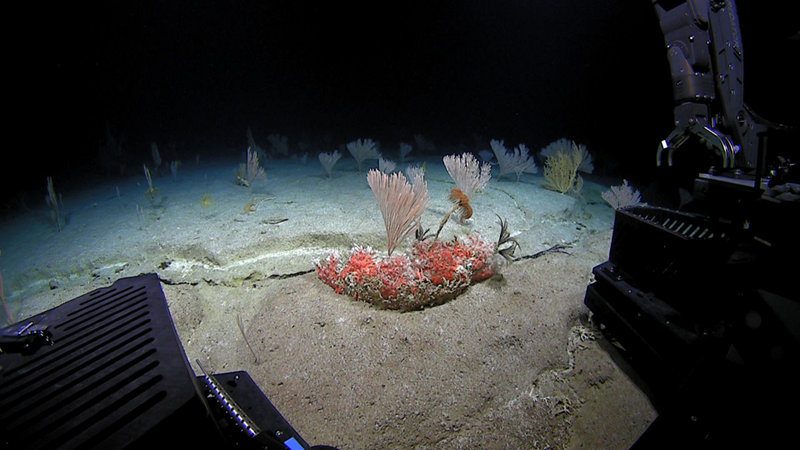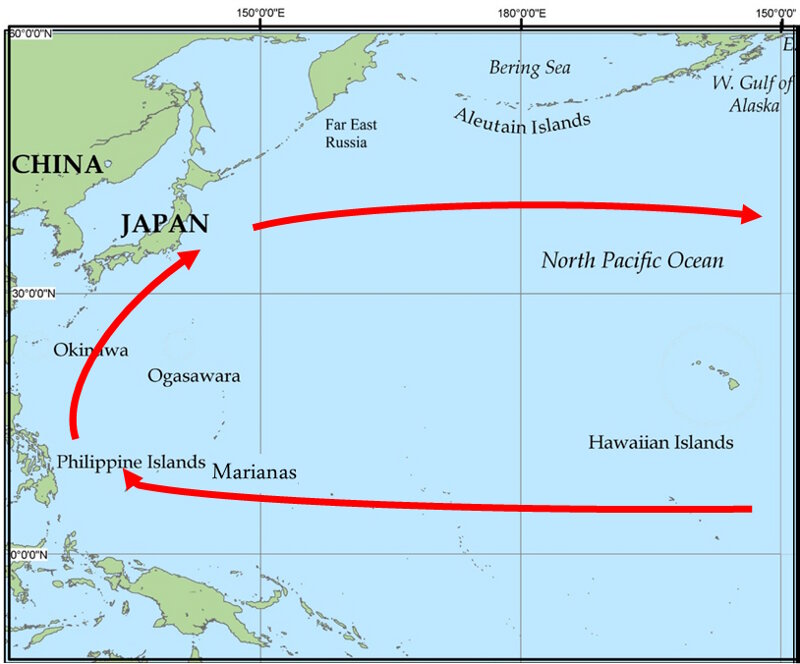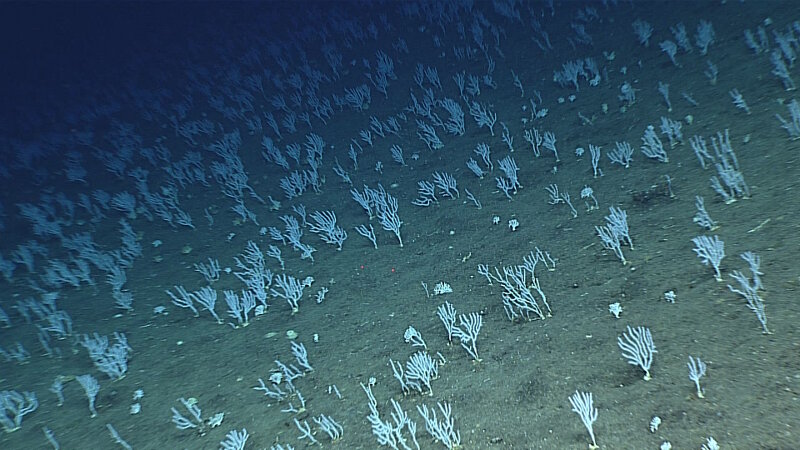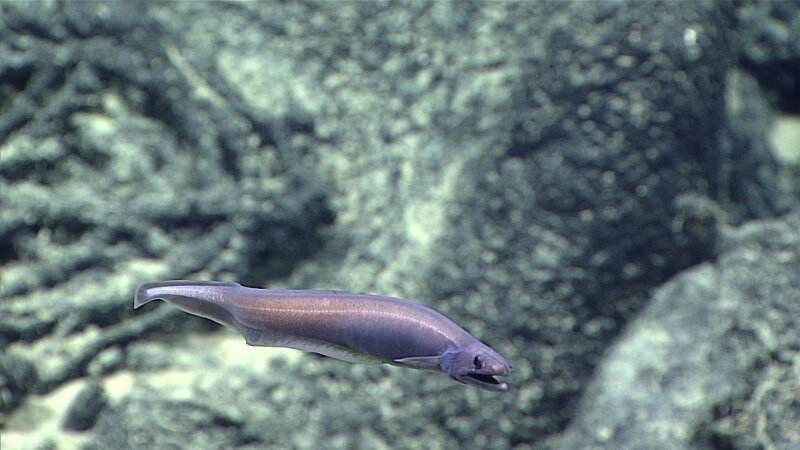
Asako K. Matsumoto - Planetary Exploration Research Center, Chiba Institute of Technology
May 10, 2016

The low, wide coral toward the bottom of the photo is precious red coral (Corallium sp.). These corals are valuable as jewelry. Image courtesy of NOAA Office of Ocean Exploration and Research, 2016 Deepwater Exploration of the Marianas. Download larger version (jpg, 941 KB).
When you look at the seamounts and islands of the Mariana region on a map, you see that they are far, far away from other island groups. The Mariana Islands are located about 6,400 kilometers from Hawaii; 2,500 kilometers from the main islands of Japan; 2,200 kilometers from the Philippines; and 1,800 kilometers from Papua New Guinea.

Map of the dominant currents around the Ogasawara and Mariana Islands regions. Image courtesy of NOAA Office of Ocean Exploration and Research, 2016 Deepwater Exploration of the Marianas. Download larger version (jpg, 280 KB).
In preparation for the current expedition, the participating biologists tried to find species records and literature for this region to help plan for our observations, but we could hardly find anything. Because the deep water of the Marianas is so poorly studied, biologists do not yet know which regions have similar fauna, necessary information to have for understanding connectivity in the deep sea. That is why this expedition is essential to get more information about biogeography and biodiversity in the Pacific basin. Some key questions that we are seeking to answer on this expedition are:
For the last question, the answer is clearly no.
The Mariana region consists of chain islands and seamounts along the Mariana Trench. Usually, much of the land-based fauna of oceanic islands are endemic because they are so isolated from other land. To the north of the Northern Mariana Islands are the Ogasawara Islands and the Izu-Ogasawara Trench. The distance between the Marianas and the Ogasawaras is about 1,400 kilometers, and it is about 1,000 kilometers to Ogasawara from the main islands of Japan. Like other isolated oceanic islands, such as the Hawaiian Islands or the Galapagos, the Ogasawaras have a high level of endemism on land; for example, over 90 percent of native land snail species are endemic.

A high-density coral garden that we surveyed at Zealandia. Image courtesy of NOAA Office of Ocean Exploration and Research, 2016 Deepwater Exploration of the Marianas. Download larger version (jpg, 1.3 MB).
Some deep-sea species in the Ogasawara Islands are also unique to that region. I described a new deepwater octocoral species (Family Melithaeidae) from Ogasawara in 2015, which was last collected over 120 years ago that we know of and was never described or studied. I named this species Melithaea boninensis, after the Bonin Islands (another name for the Ogasawara Islands). At the same time, there is some similarity between the coral fauna along the Izu-Ogasawara Arc Trench and the North Japan main islands. The southeast end of Izu-Ogasawara Trench is connected to the north end of the Mariana Trench, with a seamount separating the two trenches. Because of this proximity, it is possible that there is some connectivity between the coral fauna of the Ogasawara and Mariana regions.
The biologists participating in the Deepwater Exploration of the Marianas expedition have noted that they see many similarities between the fauna of Hawaii and the Mariana region. I agree with this and also see some similarity between the corals of the Ogasawara and Mariana regions. During the dives in this expedition, we have seen very beautiful, high-density coral gardens that appear to be of the same genus that I have collected from Ogasawara expeditions in the same depth range.
Ogasawara Island is known as precious coral habitat in Japanese waters, although the peak of the coral fishery by the Japanese in the Ogasawara region was around 1920. In recent years, illegal collection of precious corals by foreign vessels has increased, threatening coral communities. Understanding the full range and connectivity of populations of precious corals are objectives of some dives in this Mariana expedition and is crucial to managing precious coral resources.

A synaphobranchid eel observed during this expedition. This is in a different family than the Japanese eel, Anguilla japonica. Image courtesy of NOAA Office of Ocean Exploration and Research, 2016 Deepwater Exploration of the Marianas. Download larger version (jpg, 920 KB).
Another animal which suggests faunal connection between the Japanese and Mariana region is the Japanese eel, Anguilla japonica. The adult anguillid eel is distributed along the coasts of Taiwan, Korea, China, and Japan along the warm Kuroshio current from South-West to North-East. However, their spawning area is not around Japan. The eels migrate for thousands of kilometers from Japan to the west of the Mariana Islands to spawn! European eels undertake similarly long spawning migrations.
The Japanese eel migration demonstrates that there is not only a north-south connection between Japan and the Mariana region, but there is also a direct connection from the Mariana region to the Western Pacific via the North Equatorial Current. This means there is a large circle of distribution and connection among Mariana - Northwest Pacific - East China Sea - Japan. However, we don't know how many species are endemic and what percentage of fauna is shared among these regions. The ongoing observations of this expedition are helping us to understand the intricate connectivity between these deep-sea regions.